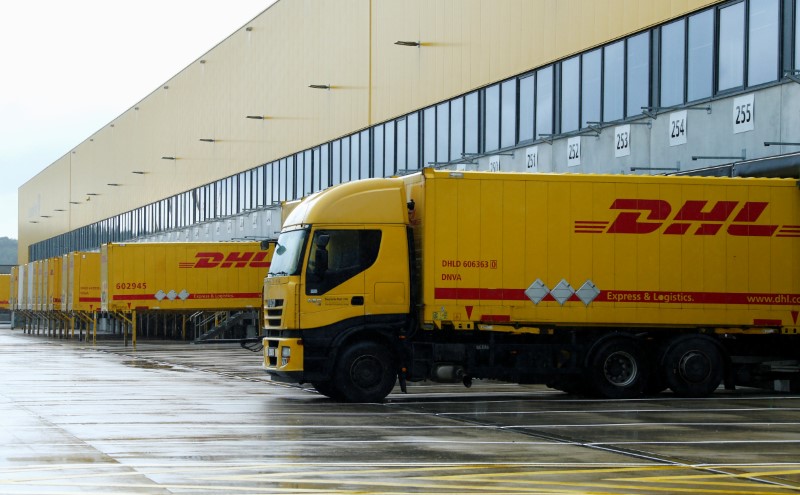China’s Xi speaks with Trump by phone, discusses Taiwan and bilateral ties
Investing.com -- Jefferies analysts have initiated coverage on three major European transport and logistics companies, namely, DHL (ETR:DHLn), DSV (CSE:DSV), and Kuehne + Nagel (SIX:KNIN) (KNIN).
The analysts flag key differentiators in the industry, particularly capital allocation, growth strategies, and the shifting dynamics between air and sea freight.
The investment stance from Jefferies places a "buy" rating on DHL and DSV, with a price target of €60 and DKK 1,700, respectively, while KNIN is rated as "hold" with a price target of CHF 240.
The primary factor influencing performance in the sector has been the approach to capital allocation.
DSV has adopted an aggressive stance, leveraging acquisitions as a key growth driver. The upcoming integration of Schenker is expected to contribute significantly to earnings, with Jefferies estimating a DKK 4.5 billion synergy realization by 2028.
In contrast, DHL and KNIN have focused more on returning capital to shareholders, opting for fewer major acquisitions.
Organic growth has remained relatively steady across the three companies. Between 2018 and 2023, DSV delivered a 93% EBIT increase, equating to a 14% compound annual growth rate. DHL achieved 70% growth at an 11% CAGR, while KNIN saw a 64% rise at a 10% CAGR.
However, DSV’s acquisitive strategy has been the most aggressive, driving an overall EBIT increase of 202% during this period, while KNIN and DHL experienced more moderate growth at 93% and 74%, respectively.
Past acquisitions such as Panalpina and Global Integrated Logistics significantly boosted DSV’s earnings, whereas KNIN and DHL pursued smaller deals, such as Apex and Hillebrand, with a more measured approach.
Market conditions for 2025 indicate a preference for air freight over sea freight. While air cargo may face regulatory challenges in the U.S. due to changes in de minimis shipment rules, its relative pricing remains at historical lows.
The ability of air freight to adapt more swiftly to market conditions than sea freight strengthens the case for DHL, which has substantial exposure to this segment. Meanwhile, the sea freight market faces downside risks.
A potential resolution to Red Sea disruptions could inject over 10% additional shipping capacity, further pressuring rates, which are already expected to see incremental supply growth of 4-7% annually through 2027.
Between 2018 and 2024, sea freight rates accounted for up to 42% of gross profit fluctuations in forwarding, compared to 25-40% for air freight rates, making rate volatility a key determinant of earnings performance.
Valuation disparities among the three companies present opportunities for investors. DSV currently trades at a premium to KNIN, a dynamic that has shifted multiple times in the past year.
KNIN, with its heavier reliance on sea freight, may experience some near-term positive sentiment, but its long-term growth prospects remain limited.
DHL’s valuation remains discounted due to its capital expenditure cycle, yet as this cycle winds down and air freight conditions improve, Jefferies sees room for upside.
DSV is trading at 17.3 times EV/EBIT for 2025, a figure expected to decline to 12.6 times by 2027. The company maintains strong cash conversion, with 65% of EBIT converted to free cash flow between 2018 and 2024.
It has actively repurchased shares to offset dilution from acquisitions, reinforcing its capital efficiency. DHL, on the other hand, trades at 9.2 times EV/EBIT for 2025, with a high free cash flow yield of 6.8%.
The company invested heavily in capital expenditures, including a €3 billion Boeing (NYSE:BA) 777 freighter fleet expansion, which temporarily reduced its cash conversion to 40% of EBIT. Excluding these capital investments, its free cash flow conversion would have been closer to 50%.
Meanwhile, KNIN is currently trading at 18.1 times EV/EBIT, slightly above DSV. It maintains strong cash generation, converting 68% of EBIT to free cash flow, and has a high dividend payout ratio of 75%.
DSV’s key focus over the next 12 months will be the realization of synergies from the Schenker acquisition and the direction of freight yields.
With projected EBIT growth of 15-20% through 2028 and disciplined capital allocation, it remains well-positioned for sustained performance.
DHL’s Express segment continues to be a core earnings driver, and expected improvements in operating leverage should support profitability.
The company’s shift toward a stronger air freight presence, along with a reduction in capital expenditures, is expected to enhance its financial position.
Meanwhile, Kuehne + Nagel faces headwinds due to its reliance on sea freight. Although well-managed, its limited inorganic growth opportunities and exposure to a weakening sea freight market present challenges.
